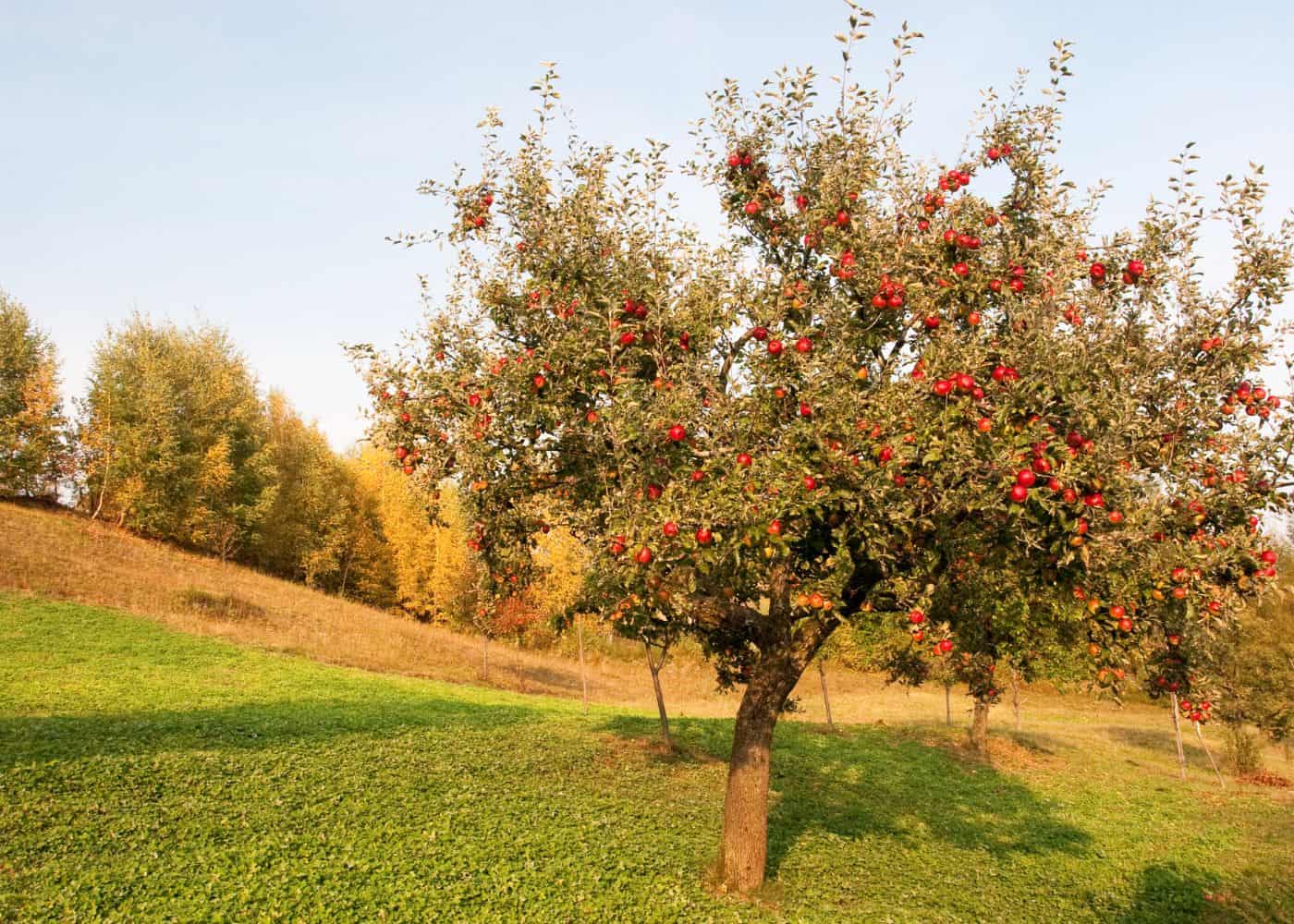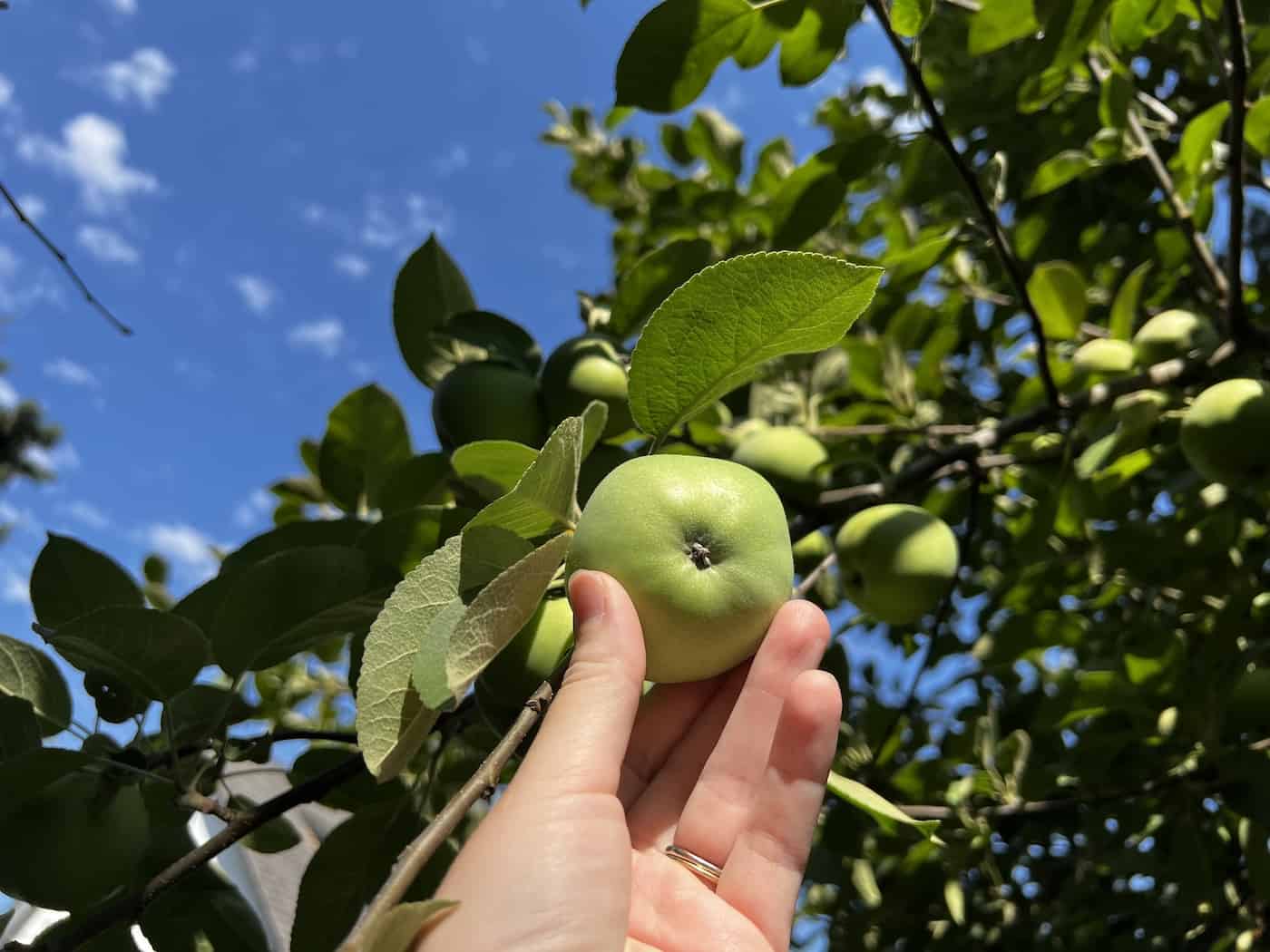Apple trees grow to a wide range of heights, from 6 feet tall to about 30 feet tall. Dwarf apple trees have been developed to reach only about 6-12 feet tall at maturity. Semi-dwarf apple trees tend to grow to a height between 12-20 feet tall. Standard full-size apple trees usually reach 20-30 feet tall at maturity.

How tall do apple trees grow?
Apple trees typically grow in the range of 6 feet tall (for dwarf trees) up to 30 feet tall (for full-sized wild trees). The height an apple tree grows to depends mainly upon the rootstock but also the cultivar’s genetics and growing conditions. Apple trees tend to grow most vigorously when planted in a sunny location in well-drained, rich soil where they have access to plenty of fresh water.
Apple trees grow at a moderate growth rate. Grafted trees generally take about 5 years to start to bear fruit and will not reach close to full size until they are about 7-10 years old. Seedling trees generally take a few years longer to grow to maturity than grafted trees.

Dwarf apple tree height
Dwarf apple trees have been developed to reach only about 6-12 feet tall at maturity. Dwarf apple trees are created by grafting the stem of a gourmet apple variety onto the rootstock of a naturally short type of apple tree.
Dwarf apple trees generally need to be supported with a stake or other vertical support system as the root system is quite small and may not be able to help the tree resist strong winds. Read the instructions carefully if you purchase a dwarf apple tree and follow them closely.
“Except in the case of the few varieties that are naturally dwarf because of their genetics, dwarf trees are made so by grafting. A stem of a particular variety is grafted onto a special dwarfing rootstock and the resulting tree, from the graft upward, is of that variety now kept from growing too big. The fruit itself is not dwarfed.”
Landscaping with Fruit, by Lee Reich
The smallest dwarf trees are commonly made using the M27 rootstock variety from the Malling Research Station in the UK. Trees grafted onto the M27 dwarf rootstock grow to reach about 6 feet tall at maturity.
- M27 reaches 6 feet tall. It is good for container growing, small spaces, and intensive low plantings.
- M9 reaches 8 feet tall. It develops a bushy tree form perfect for small gardens and intensive orchard plantings.
- M26 reaches 10-12 feet tall. This rootstock is traditionally considered a “dwarf” but is vigorous enough for some growers to consider it semi-dwarf. This rootstock has been used extensively in commercial orchards.

Semi-dwarf apple tree height
Semi-dwarf apple trees typically grow to reach between 12-20 feet tall. These trees often need to be supported with a stake or trellis fence due to their small root systems.
The common old semi-dwarf rootstock is called M.7 (Malling 7). Here are some other semi-dwarf apple rootstocks:
- M106 reaches 14 feet tall. It develops a bush form making it well-suited to larger orchards.
- G.935 reaches about 14 feet tall and is disease-resistant.
- G.890 reaches about 16 feet tall and is disease-resistant.
- G.969 reaches about 16 feet tall and is self-supporting.
- M.7A reaches about 18 feet tall and is disease resistant and self-supporting but tends to sucker.

Standard full-size apple tree height
Standard full-size apple trees usually reach 20-30 feet tall at maturity. This includes own-root trees and wild apple trees that grew from seed.
The root systems of these trees are large and strong enough to support the weight of a full-size apple tree. Standard apple trees require no staking or other support structures unless they are damaged or uprooted in a storm.

Standard apple trees generally take up a wide space, with a diameter of up to 30 meters across. They are not well-suited to small gardens or modern orchards.
The root system of a full-size apple tree can be very aggressive and damaging to sidewalks, driveways, and foundations. If you have a standard apple tree growing on your property, make sure to keep an eye on the roots and have them trimmed back if needed.

How to keep apple trees small
Apple trees can be kept smaller than they would usually grow with selective pruning and training methods. This includes growing them in large containers, spindle training, and espalier.
Start by picking a true dwarf tree from the local nursery. The mature height of a dwarf apple tree should be 12 feet or less.

Dwarf apple trees can be grown in large containers like a half wine barrel. Be sure to use a high-quality potting mix plus some natural garden soil and give the tree plenty of water. Dwarf apple trees grown in containers will need to be fertilized more often than those grown in the ground.
Spindle training is a method of pruning and shaping an apple tree to create a slim, columnar shape. This can be done with any size apple tree but is most commonly done with semi-dwarf trees.
Espalier is a method of training an apple tree to grow against a wall or fence in a flat, two-dimensional plane. This is usually done with dwarf and semi-dwarf apple trees. You can espalier apple trees up against a sunny fence or against the side of a structure where they will be protected from harsh winds.
When pruning an apple tree, always make sure to sterilize your pruning shears with rubbing alcohol or a bleach solution to prevent the spread of diseases.

How to grow tall apple trees
To grow a tall apple tree of about 30 feet in height, first look for a very healthy young tree that’s clearly labeled as having a full-size rootstock. These are increasingly difficult to find as orchardists move to intensive spindle planting of semi-dwarf trees.
Planting apples for vigorous growth
Next, find a planting location with rich, sandy loam soil that gets a minimum of 6-8 hours of direct sunlight per day (direct sun).
The planting hole should be about twice the width of the root ball but no deeper. Pour some water into the hole and check to make sure it drains out easily. Then place the root ball in the hole, unfurling any tightly circling roots.
Backfill the hole with the soil that came out of it. The level of the soil around the base of the tree should be the same as the tree in the pot. Roots should be buried, but all bark on the trunk should be above the ground. Don’t bury the tree any deeper than it was in the pot.
After backfilling the planting hole with soil, water the tree well and mulch around the base of the tree with 2-3 inches of organic mulch. Keep the mulch away from the trunk to prevent rot.
Maintenance tasks for growing healthy apple trees
Stake the young tree with two wooden or metal posts driven into the ground on either side of the trunk. Use wide, stretchy fabric ties to attach the tree trunk to the posts. The stakes should be at least 6 feet tall and driven 2 feet into the ground. The tree should be staked for at least one full growing season, but preferably two.
Water the tree regularly during the first growing season to help it establish a deep and extensive root system. Once established, apple trees are quite drought-tolerant.
Fertilize young apple trees every spring with a balanced fertilizer. Follow the package directions for how much to apply based on the tree’s size. Mature apple trees should be fertilized every other year in early spring.






